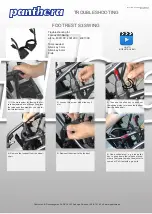
2
TRANSIT SECUREMENT
A. GENERAL WARNINGS
WARNING
When feasible, wheelchair occupants should transfer into
the vehicle seat and use the OEM (Original Equipment
Manufacturer) vehicle-installed restraint system.
WARNING
As of the date of this publication, the Department of
Transportation has not approved any tie-down systems
for transportation of a user while in a wheelchair, in a
moving vehicle of any type. It is Sunrise Medical’s position
that users of wheelchairs should be transferred into
appropriate OEM seating in vehicles used for
transportation and that the restraints made available by
the auto industry be used. Sunrise Medical cannot and
does not recommend any wheelchair transportation
systems.
Use only Wheelchair Tie-down and Occupant
Restraint Systems (WTORS) which meet the
requirements of the SAE (Society of Automotive
Engineers) J2249.
You may obtain a copy of this document by contacting
SAE International at:
400 Commonwealth Drive
Warrendale, PA 15096-0001
1.877.606.7323 (U.S. and Canada only)
1.724.776.4970 (Outside U.S. and Canada)
WARNING
It is important to note that the chairs and transit options
included in this Supplement have been designed for use by
occupants that weigh more than 51 lbs (23kg). Do not
attempt to use this chair in a transit situation for an
occupant that weighs less than 51 lbs
(23kg), as they will
not be restrained properly, and in the event of an
accident, there is a risk of serious injury or death.
WARNING
The buckle of the belt restraint system should not be
located near any item that may come in contact with the
buckle release button in the event of a vehicle accident or
collision.
WARNING
If a recline angle is required during transport, the manual
chair seat/back should be positioned at an angle of no
more than 30° to the vertical or the occupant is at risk of
injury from sliding under the restraint in the event of an
accident or collision while in the motor vehicle.
WARNING
Visually inspect all WTORS equipment at least once per
month, and have worn or broken components replaced
immediately.
QUI CK I E/ Z IP P I E
WARNING
Interior components that can’t be removed from the
clear zones should be padded with material that
complies with FMVSS201.
WARNING
Although postural supports and belts may be used in a
moving vehicle in addition to the occupant belt
restraint system, they should not be relied upon to
replace occupant restraints that have been designed and
tested for the purpose of securing an occupant during a
motor vehicle collision or accident. Any postural
supports that can be used during transit, must be
positioned so that they do not interfere with the clear
path for proper transit securement belt restraint.
WARNING
Backrests of wheelchairs with adjustable seat angles
must not be tilted to more than 30°. Do not alter or
substitute wheelchair frame parts, components, or
seating systems.
WARNING
A sudden stop and/or collision may structurally damage
your wheelchair. Wheelchairs involved in sudden stops
should be inspected for possible failures in frame
and/or components. Wheelchairs involved in collisions
should be replaced.
NOTE- The warranty is void on any wheelchair that is
involved in a collision.
B. WTORS AND PROPER SET-UP
WARNING
1. The wheelchairs listed in this supplement have
been dynamically tested in a forward-facing mode
with a specified crash test dummy restrained by
both pelvic and upper-torso belt(s) (shoulder
belts). Both pelvic and upper-torso belt(s) should
be used to reduce the risk of head and chest
impacts with vehicle components.
2.
Testing was performed for seating in a motor
vehicle with the factory installed seating system
only. The wheelchairs must be in a forward facing
position during travel in a motor vehicle.
3.
The wheelchairs referred to in this supplement
have been equipped and dynamically tested to rely
on wheelchair-anchored pelvic belts.
4.
To reduce the potential for injury, both pelvic and
upper-torso belts should be used in a transit
situation.
MK-100072 Rev.
G


























